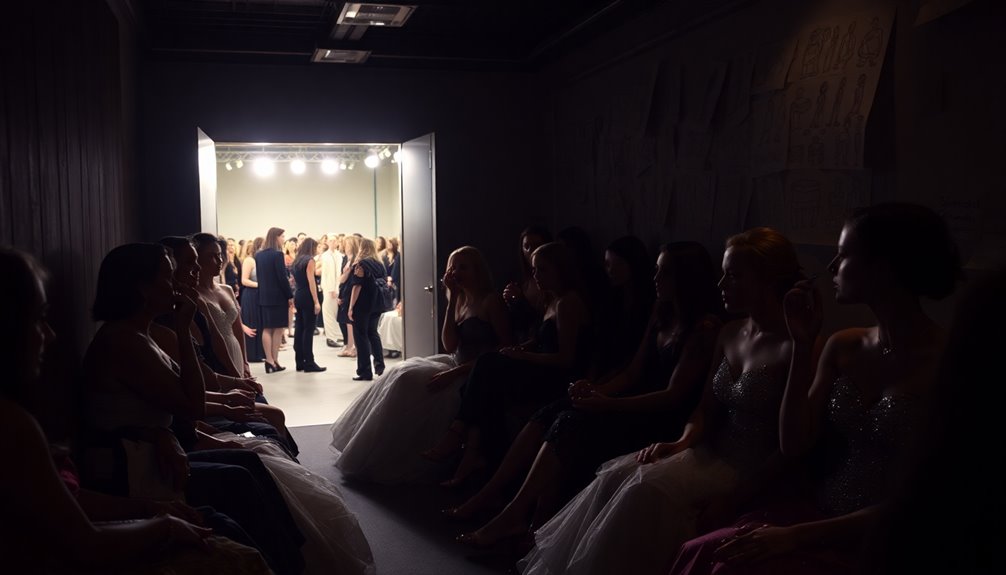Fashion Weeks might seem enchanting, but there's a hidden side you should know about. Designers often spend staggering sums, risking financial ruin for fleeting visibility. Behind the glitz, unpaid interns and overworked laborers face exploitation, their contributions largely overlooked. High-profile shows can create unachievable beauty standards, while corporate sponsors cash in on the spectacle without guarantee of returns. This glamorous façade masks significant environmental impacts, and diversity issues remain prevalent. If you think that's the extent of the secrets, there's so much more you'll uncover about the intricate dynamics of this fascinating world.
Key Takeaways
- Fashion Weeks often mask systemic exploitation, with unpaid internships and low-wage labor underpinning high-profile events.
- Many designers gamble their financial stability for visibility, highlighting the precarious nature of the fashion industry.
- Sponsorships are crucial for funding shows, yet their unpredictable nature reveals the tension between creativity and commerce.
- Environmental impact is significant, as fast fashion contributes to waste and pollution, despite a growing push for sustainable practices.
- The glitz of Fashion Weeks often overshadows the stark wealth disparity and ethical dilemmas faced by workers in the industry.
The Business of Fashion Weeks
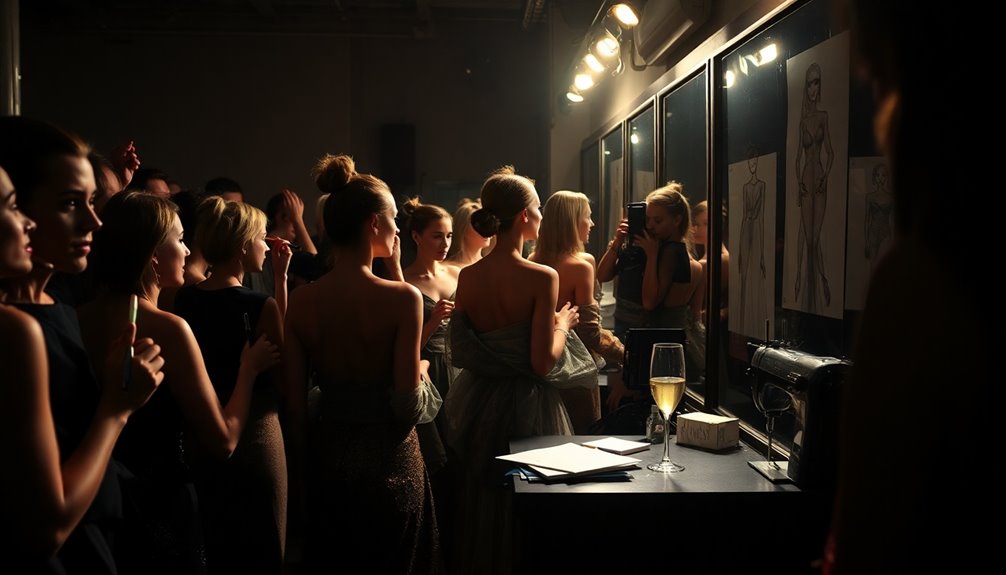
When you plunge into the world of Fashion Weeks, you'll quickly realize it's more than just a showcase of stunning designs; it's a high-stakes business venture. The fashion industry thrives on massive financial investments, with high-profile designers spending upwards of $500,000 on a single show.
For smaller designers, the risk is even greater, often jeopardizing their financial stability. Corporate sponsors pour millions into these events for brand visibility, but sponsorships don't always guarantee returns.
As you observe the spectacle, remember that many designers gamble their last resources to make a mark. With celebrity endorsements driving fame and sales, the cycle of conspicuous consumption and wealth disparity becomes glaringly evident, highlighting the true complexities behind the glamour.
Behind the Glamour
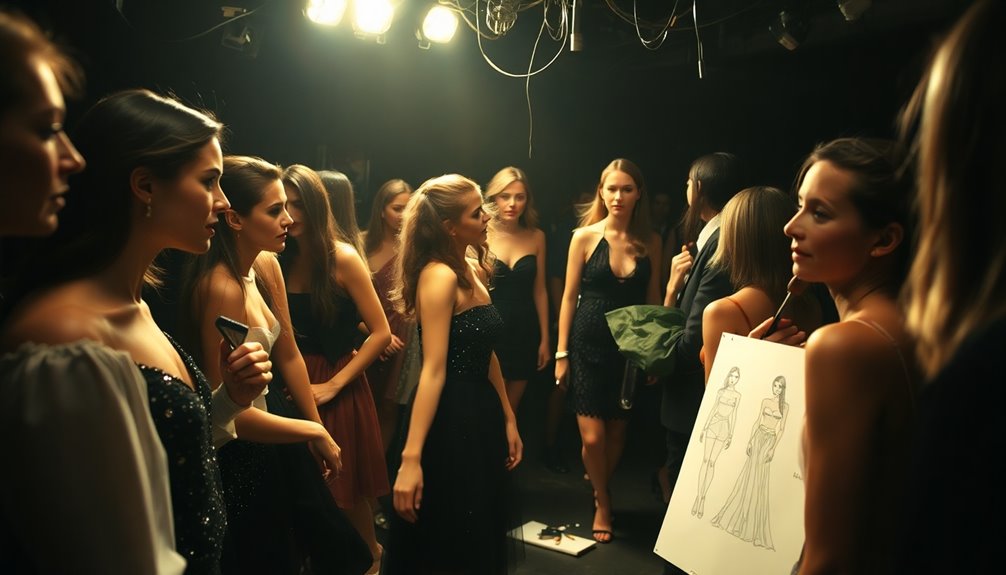
While the glitz and glamour of Fashion Weeks capture your attention, there's a stark reality lurking beneath the surface. Fashion shows often serve as high-stakes marketing campaigns, draining resources from designers who risk financial stability for fleeting visibility.
A-list celebrities bask in the spotlight, while unpaid interns and manual labor roles are overlooked, revealing systemic exploitation and unethical labor practices. This hierarchy not only highlights the disparity within the fashion community but also reflects broader economic inequality.
As the industry promotes conspicuous consumption, it perpetuates wealth disparity, aligning with Thorstein Veblen's concept of invidious comparison. The stunning visuals may dazzle you, but they often mask the harsh truths of an industry steeped in inequality and exploitation.
The Art of Unwearable Fashion
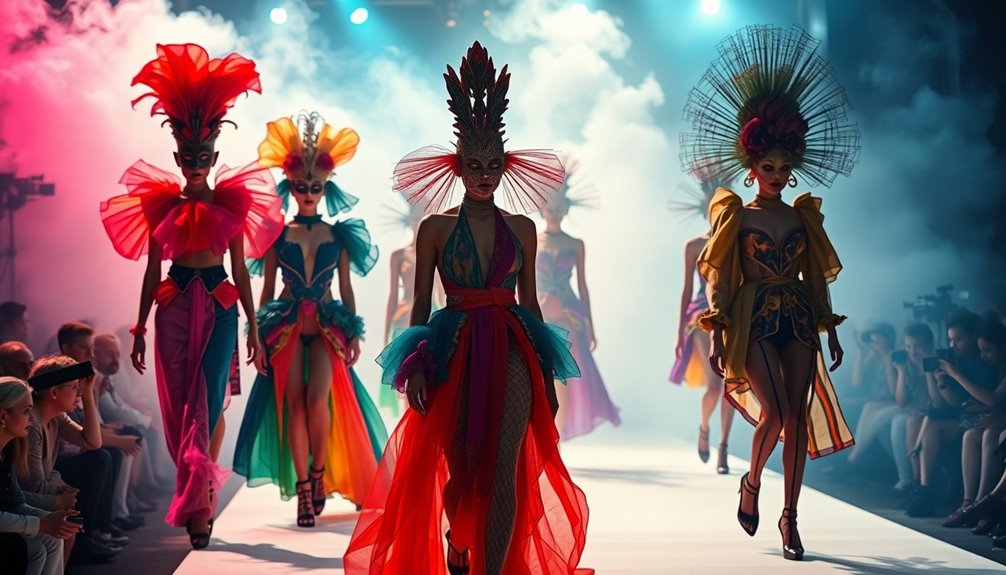
Unwearable fashion isn't just about outrageous designs; it serves as a powerful commentary on society.
By challenging conventional beauty standards, designers push you to rethink what fashion can be.
This artistic expression often blurs the lines between clothing and sculpture, igniting conversations that resonate far beyond the runway.
Artistic Commentary on Society
Fashion often serves as a mirror reflecting societal values and beliefs, and unwearable fashion pieces push this concept further by challenging our perceptions of beauty and identity.
Fashion designers utilize avant-garde presentations to provoke thought and spark discussions on body image and societal norms. By showcasing garments that often defy traditional wearability, they elevate fashion to an art form, emphasizing conceptual storytelling over consumerism.
These high-profile runway shows act as intellectual exercises, eliciting strong emotional responses, whether love or hate, and steering clear of indifference. In doing so, designers not only establish themselves as artists but also contribute to a legacy of societal critique, reinforcing the notion that fashion can explore and challenge the complexities of modern life. This evolution of fashion design is reminiscent of the principles of haute couture, which emphasize intricate details and unique artistry.
Challenging Fashion Norms
Challenging established norms, unwearable fashion boldly redefines what clothing can be. This avant-garde movement isn't just about outrageous designs; it's a deep exploration of creativity that critiques societal expectations around beauty and body image.
Designers like Comme Des Garçons create pieces that resemble modern art, sparking conversations rather than serving practical purposes.
- Pushes the boundaries of traditional fashion
- Utilizes unconventional materials and techniques
- Reflects broader cultural and ethical conversations
- Serves as artistic commentary on societal norms
- Influences future mainstream fashion trends
Navigating Industry Dynamics

As you explore the world of Fashion Weeks, you'll quickly realize that maneuvering through the industry's complex dynamics requires more than just an eye for style. The financial stakes are staggering, with high-profile designers spending over $500,000 on a single runway show, while smaller designers often risk everything for visibility.
Interns face exploitation, working for free and enduring poor treatment, revealing the stark contrast between creators and consumers in fashion events. This hierarchy extends to manual labor roles, overlooked and undervalued despite their essential contributions.
While corporate sponsors invest millions for brand visibility, the returns are never guaranteed. Ultimately, Fashion Week obscures deeper societal issues like labor exploitation and wealth disparity, emphasizing the need for critical engagement with these dynamics.
The Influence of Sponsorships

Sponsorships play a vital role in the success of Fashion Week, providing the financial backing that many designers need to showcase their work.
These partnerships not only help cover hefty production costs but also offer brands valuable exposure opportunities in a crowded marketplace.
Understanding this influence can shed light on the intricate dance between creativity and commerce in the fashion industry.
Financial Backing Importance
While many designers dream of showcasing their collections on the prestigious Fashion Week runway, the reality is that financial backing plays a crucial role in turning that dream into a viable reality.
Corporate sponsors invest millions, but the financial returns can be elusive. Here's what you need to know:
- High-profile shows can cost over $500,000.
- Smaller designers risk their financial stability for exposure.
- Sponsorship is a high-stakes marketing venture.
- Success often relies on media coverage and celebrity endorsements.
- The cycle of conspicuous consumption highlights wealth disparity.
In this world, financial backing isn't just helpful; it's often indispensable for survival, making or breaking a designer's dreams at Fashion Week.
Brand Exposure Opportunities
Brand exposure opportunities at Fashion Week can make or break a designer's reputation, especially when corporate sponsors back their presentations. With sponsorships pouring millions into these events, the stakes are exceptionally high.
High-profile designers like Michael Kors spend over $500,000 on a single runway show, aiming to capture media attention and consumer interest. However, sponsorships don't guarantee financial returns; many brands find that exposure doesn't always translate to sales.
Celebrity endorsements play an essential role in enhancing brand exposure, as the right dress on a star can elevate a brand's visibility markedly.
Ultimately, while fashion week serves as a high-stakes marketing campaign, the impact of sponsorships remains unpredictable, highlighting the complex relationship between exposure and actual profitability.
Diversity and Representation Issues
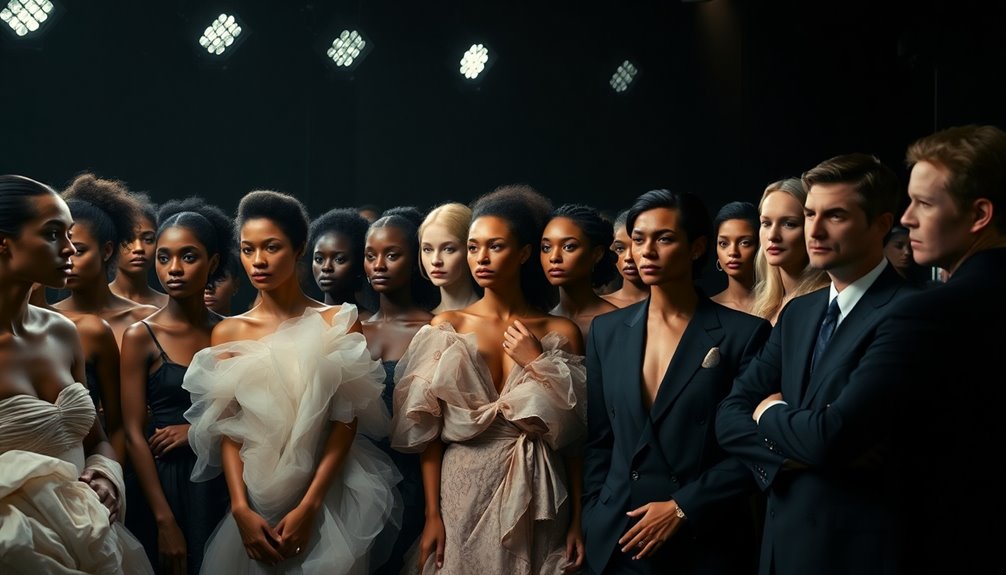
As the fashion industry evolves, the need for genuine diversity and representation at Fashion Week becomes increasingly urgent.
Despite some progress, many issues persist that hinder inclusivity:
- Limited Asian representation at events, often leading to media clustering.
- Ongoing gatekeeping practices that favor Western dominance in luxury fashion.
- Homegrown publications face significant barriers to access major fashion events.
- Although icons like Heart Evangelista and Pia Wurtzbach shine, diverse cultures remain underrepresented.
- The push for inclusivity continues, highlighting the urgent necessity to amplify diverse voices.
It's essential for the industry to actively address these challenges.
Only then can we hope to create a vibrant fashion landscape that truly reflects the richness of global cultures and identities.
Survival Tips for Attendees

How can you make the most of your experience at Fashion Week? Here are some survival tips to guarantee you're comfortable and prepared for this whirlwind event. First, dress for comfort—choose stylish flats over heels to keep your energy up. Pack essentials like versatile clothing pieces to simplify your travel. Don't forget to stay hydrated and bring healthy snacks to maintain your stamina throughout the day. Also, consider enlisting help from friends or interns to manage your busy schedule. Finally, cultivate an air of confidence; it can help you navigate entry barriers and make a strong impression.
| Tip | Importance | Outcome |
|---|---|---|
| Dress for Comfort | High | Sustained Energy |
| Pack Essentials | Medium | Simplified Travel |
| Bring Help | High | Streamlined Experience |
The Ethical Dilemmas in Fashion

While maneuvering through the excitement of Fashion Week, it's easy to get swept up in the glamour and fast-paced world of style.
But beneath the surface, ethical dilemmas lurk, challenging your perception of fashion.
- Exploitative labor practices are rampant in garment production.
- Unpaid internships highlight questionable industry standards.
- High-profile designers often overshadow the workers who create their collections.
- Economic inequality is starkly visible during lavish events.
- The cycle of conspicuous consumption perpetuates wealth disparity.
You might find it shocking how the industry's glitzy facade conceals serious human rights issues.
As you enjoy the spectacle, remember the stories behind the seams and consider the impact of your choices in this complex world.
Frequently Asked Questions
Do Designers Really Expect Us to Wear Those Ridiculous Clothes?
You might wonder if designers really expect you to wear those outlandish clothes. The truth is, they often don't.
Many runway pieces serve as artistic expressions, challenging norms and provoking thought rather than being practical. These garments showcase creativity and storytelling, emphasizing high fashion's divide from everyday wear.
While they might seem absurd, they can inspire future trends that are more wearable, allowing you to connect with the artistic vision behind them.
Can a Normal Person Go to Fashion Week?
Absolutely, a normal person can attend Fashion Week! It's not just for industry insiders anymore.
By networking and leveraging social media, you can secure an invitation. Many shows now embrace inclusivity, welcoming influencers and fashion enthusiasts alike.
To stand out, showcase your personal style and confidence. Know the schedules and key brands, and come prepared with stylish yet comfortable shoes—this'll help you navigate those bustling days and make meaningful connections.
What Is the Most Prestigious Fashion Week?
When you think about the most prestigious fashion week, Paris Fashion Week comes to mind.
It's where top designers and luxury brands showcase their latest creations, attracting elite media coverage and fashion icons.
You'll see the latest trends and witness the craftsmanship that defines high fashion.
While New York, Milan, and London also hold significant influence, Paris remains the pinnacle of glamour and prestige in the fashion world.
You can't miss it!
Do Celebrities Get Paid to Attend Fashion Week?
You might think celebrities pocket cash for gracing Fashion Week with their presence, but it's more nuanced.
While they don't typically receive direct payments, they enjoy a treasure trove of perks. Through brand partnerships and gifted designer outfits, their attendance boosts their visibility and future earning potential.
This relationship is a win-win; brands gain exposure, and you get to see your favorite stars sparkling in the latest trends.
Isn't that a delightful arrangement?
Conclusion
As the curtains fall on fashion weeks, remember that beneath the glitz lies a tapestry woven with ambition and compromise. The allure of the runway may dazzle your senses, but it's the whispers of industry secrets that linger long after the lights dim. Embrace the thrill of the spectacle, but keep your eyes peeled for the hidden truths. In this world of fabric and dreams, you're not just an observer; you're a part of the unfolding story.

